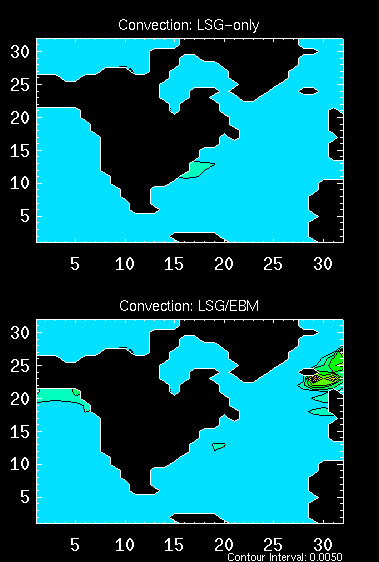
The "Open Panama" test run of the coupled LSG/EBM model produced an interesting result: the thermohaline circulation of the North Atlantic did not collapse, despite the fact that it did when the LSG model alone was used. Why the difference between the two cases? This note tries to answer this question.
The essence of the difference between the LSG/EBM run and the LSG-only can be seen in Figure 1, which compares the time evolution of the meridional overturning circulation for the two.

The LSG-only run collapses to essentially no North Atlantic overturning within 400 years, while the LSG/EBM continues to form NADW (albeit at a diminished volume flux) for at least 10,000 years.
Where is the convection associated with the LSG/EBM's continuted thermohaline overturning happening? Figure 2 shows the location of convection in the North Atlantic for the LSG-only model and the LSG/EBM, both shown at T=500 years.

The convection in the coupled LSG/EBM is basically confined to a region East of Iceland, so I will concentrate on that geographical region in some of the plots below.
The reason for the collapse of the North Atlantic thermohaline circulation in the LSG-only run is as explained in the paper by Tom Crowley and Uwe Mikolajewicz--with the open panama, fresh water can flow out of the North Pacific into the North Atlantic, capping off the water column and shutting down convection. The surface salinity fields for the LSG-only run at year 0, year 400 (when the N. Atlantic thermohaline circulation is shut off), and the difference between them (year 400 - year 0) is shown in Figure 3.

Particularly in the difference plot, the freshening of the North Atlantic by 3 to 4 ppt can easily be seen. This is, of course, a substantial difference in salinity; even if the surface temperature were lowered to the freezing point, this fresher surface water would be too light to sink (ignoring the possibility of brine rejection).
So what happens with the LSG/EBM? Well, Figure 4 shows the surface salinities for the coupled LSG/EBM, in the same format as Figure 2.

In the LSG/EBM run, the surface salinities only get about 1 ppt fresher in the northernmost part of the North Atlantic. (There is a region of greater freshening off the east coast of North America, but it seems to be related to a southward shift in the Gulf Stream, rather than an overall freshening.) In the area to the East of Iceland, the freshening is between .5 and 1.0 ppt. Even though this is only a quarter or less of the freshening of the LSG-only model, it still is a substantial difference; and it still requires explaination why the LSG/EBM run doesn't lose its North Atlantic thermoahline circulation. (It also requires some explaination why there is less freshening in the LSG/EBM--this will be described below).
One immediate difference between the models (in fact, the essence of the difference between the LSG/EBM and LSG-only models) is that the air temperature in the LSG/EBM adjusts to changes in the ocean circulation. So, for instance, if the thermohaline circulation in the North Atlantic slows, air temperatures in the LSG/EBM will drop, and the surface waters will get colder, too. This effect can be seen in Figure 4, which contrasts surface temperatures at a point in the North Atlantic (65 North, 30 West) across the two runs.

There is a noticable difference--the LSG/EBM temperatures fall faster, and to a lower value, than the temperatures in the LSG-only model. The biggest difference between the two is after about 100 years, at which point the LSG-only model is 2.5 C warmer than the LSG/EBM. This will, of course, make the surface waters of the LSG/EBM denser than in the LSG-only model--but is it enough of a difference to keep the thermohaline circulation going?